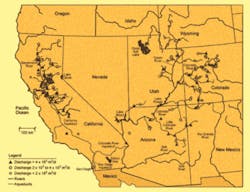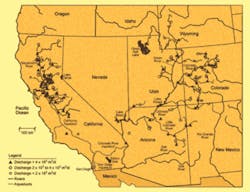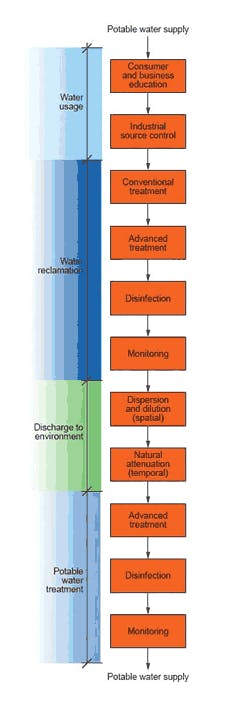by Kathleen Esposito, Ryujiro Tsuchihashi, and Beverley Stinson
Planned indirect potable reuse (IPR) is defined as the planned incorporation of reclaimed water into a raw water supply, such as in potable water storage reservoirs or a groundwater aquifer, resulting in mixing, dilution, and assimilation, thus providing an environmental buffer (M&E, 2007) before it is treated and supplied through potable water distribution systems. Planned IPR projects have been in operation in the US since the 1960s and the number of projects across the US has grown in the past few decades.
Although planned IPR systems face opposition from the public, unplanned IPR is very common without being noticed by most of the public. Waterways across the United States receive discharges from wastewater treatment plants and at the same time serve as a potable water source. Often, potable water intakes exist downstream of a wastewater plant’s discharge, resulting in the partial intake of treated wastewater for the potable water supply. Such a case is referred to as de facto IPR, or unplanned IPR. For example, two major water sources for southern California: the Colorado River and the Sacramento River, receive treated wastewater from numerous WWTPs (refer to figure of map with rivers).
With planned IPR, the perceived decrease in temporal and spatial distances between discharge and reuse raises doubts in the public eye about the quality and safety of reclaimed water. The most important consideration when planning for an indirect potable reuse project is public health protection. A variety of factors must be carefully assessed to ensure that water quality requirements are met. These factors include the treatment processes necessary to achieve the desired water quality; system reliability; changes in treated water quality during infiltration/percolation; and the quality of the existing water supply.
Wastewaters being treated for possible IPR are subject to the same stringent regulations and monitoring requirements as conventional potable water sources. As an additional challenge to expanded use of reclaimed water, there are continued uncertainties regarding the adverse health effects of unregulated compounds which have been detected in trace levels in wastewater discharges.
Unregulated compounds that have been detected in wastewater discharges include household and industrial chemicals such as flame retardants, plasticizers, detergent metabolites and commonly used pharmaceutical and personal care products such as prescription and non-prescription drugs, fragrances and anti-microbial cleaning agents. Some of these compounds are known or suspected carcinogens, others are estrogenic and have the potential to adversely affect the endocrine system of humans and aquatic organisms. The effects of others are still not well understood. The use of these compounds, popularly referred to as contaminants of emerging concern (CECs) or emerging pollutants of concern (EPOCs), is ubiquitous in every day life.
As receptacles of water discharges from communities, WWTPs are one of the primary pathways of CECs to water bodies if they persist through the wastewater treatment process, thus, it is important to determine the existence of some of these compounds and providing treatment to reduce or eliminate them.
Process optimization and the design of multiple treatment barriers is the standard to ensure protection of public health from known and unknown health risks in an IPR system. These concepts have been incorporated into both water and wastewater treatment systems to ensure safe drinking water supplies and to minimize the unexpected discharge of pollutants to the end user. In terms of multiple barriers within the water reclamation phase, technologies to remove and/or destroy both regulated and unregulated compounds are advancing and the cost of treatment is coming down.
Case Study
Although most IPR projects in the US are concentrated in Southern and Western regions, impending stress on conventional water supply from population growth and development has led many historically water rich states to explore steps to safeguard existing potable water supply sources and to investigate alternative water supply sources, including reclaimed water. Following a record breaking drought in 2002, the state of New Jersey’s Department of Environmental Protection (NJDEP) developed a guidance document for Reclaimed Water for Beneficial Reuse. To further promote reuse, the Legislature made $35 million available from a Water Supply Bond Fund for Water Supply Demonstration Projects.
Due to increasing pressures on potable water resources in its service area, Logan Township Municipal Utilities Authority (LTMUA) worked with Metcalf & Eddy (M&E) to develop a proposal to design a groundwater recharge system via direct injection based on an upgrade at the existing WWTP. The additional volume of water will replenish an aquifer system that is the primary potable water source for the region. This project was awarded one of the NJDEP Demonstration Grants and, upon final NJDEP approval, will be the first IPR project in the northeastern US.
The treatment train for the Advanced Water Treatment Facility (AWTF) at LTMUA consists of membrane bioreactors (MBR), which provide a high sludge age and a physical barrier to microbes and organics; reverse osmosis (RO), to remove dissolved contaminants and provide a second microbial barrier; and an advanced oxidation process (AOP), where hydrogen peroxide is combined with ultra violet (UV) light to provide final disinfection as well as oxidation of any ultra-low molecular weight organics.
The system was selected based on evaluation and review of other IPR systems in the US and represents the state-of-the-art for IPR technology, with finished water quality goals set to meet or exceed drinking water standards.
The product will be 750,000 gallons per day (gpd) of highly treated water, which will be injected into the local aquifer system where it will undergo further natural treatment as it moves through the aquifer and blends with native groundwater for approximately three years prior to extraction.
Pilot Testing
The LTMUA-M&E team has been working closely with regulators to ensure the highest possible water quality. The proposed treatment train was pilot tested at LTMUA from August through November 2005 to confirm performance and design criteria and to build operator understanding of the proposed processes.
Extensive sampling was conducted for a wide range of water quality parameters as flow passed through the treatment train. Performance was monitored continuously for each of the treatment processes. Most water quality parameters were monitored daily. In addition, several large-scale water quality testing programs were performed throughout the study, including testing the treated water for the full range of EPA Primary and Secondary Drinking Water Regulations and NJDEP’s Testing Requirements for Organic Toxic Pollutants for discharges to groundwater.
Testing also included three rounds of 24-hour composite sampling, in partnership with the US Geological Survey (USGS), for chemical analyses of a broad suite of trace organic wastewater contaminants: household and industrial chemicals and commonly used pharmaceuticals. The estrogenicity of the samples was also measured using an in vitro bioassay. Bioassays are used to provide an integrated measure of estrogenic potency in a water sample and compliment chemical analysis of a water sample for individual compounds. Although this testing for CECs and estrogenicity was not required, the project group determined that it was important to prove water quality went beyond conventional parameters to address growing concern from scientists, regulators and the public about unregulated compounds.
Grab samples of ground and surface water were also collected from the intake well of a water treatment facility located near the proposed groundwater recharge location and from the Delaware River close to the intake of a neighboring surface water treatment facility. The samples were collected so the team could compare the polished water from the pilot unit with the other local potable water supply source waters.
Test Results
Testing for the contaminants listed in the Primary and Secondary Drinking Water Regulations indicated effective treatment results; all but three parameters were non-detectable in the RO permeate. The parameters that were detected were well below their respective maximum contaminant level (MCL) (if established). Analysis of RO permeate for parameters listed in NJDEP’s Testing Requirements for Organic Toxic Pollutants for discharges to groundwater also indicated favorable results with all but five parameters resulting in non-detection. All parameters detected were also below the MCL (if established). For these tests, RO permeate samples were analyzed due to the small size of the bench-scale AOP reactor and the volume requirements for the trace contaminant analysis and bioassay.
The USGS used a Gas Chromatography/Mass Spectrometry (GCMS) method to detect 66 household and industrial use chemicals and a Liquid Chromatography/Mass Spectrometry (LCMS) method to detect 24 pharmaceutical compounds.
Overall, 48 of the household and industrial compounds and 12 of the pharmaceutical compounds were detected in the influent to the pilot in one or more of the three rounds of testing. An average of 26 compounds were detected in the MBR effluent stream and five compounds were detected in the RO permeate. No compounds were detected in the effluent of the AOP in any round. In comparison with the final product from the pilot, 22 compounds were detected in the grab sample of the river water and one compound was detected in the grab sample of the water supply well.
A relatively new bioassay from the US EPA (T47D-KBluc) was used to measure changes in total estrogenic activity. Preliminary analysis showed approximately 85 percent of the influent estrogenic activity was removed by the pilot MBR. Activity was further reduced to non-detectable levels in the RO permeate and, hence in the polished AOP effluent. The source water samples showed non-detectable levels of estrogenic activity as well.
Conclusions
The multiple barrier treatment train selected for the Groundwater Recharge Demonstration Project at LTMUA has proven to be a robust combination of technologies. The foremost objective of this study was to prove that the selected treatment train could effectively meet all applicable drinking water regulations and also to prove it could effectively treat a wide range of unregulated compounds. Testing showed that the quality of the finished water from the pilot AWTF was comparable to that of the aquifer water.
The research presented in this paper underscores the importance of combining knowledge and information on effluent constituents, treatment level attained, and treatment technologies employed in evaluating the suitability of reclaimed water to ensure safe and beneficial reuse into the future. The experience and knowledge gained from this novel pilot study can be an example for other water reclamation and reuse projects, particularly for IPR projects.
While planned IPR projects are subject to intense scrutiny and research, unplanned indirect potable reuse occurs with little or no control. IPR can be a safe and viable solution to localized water constraints and with further advances in treatment technologies and an understanding of the implications of CECs, IPR will continue to become an increasingly common tool in integrated water resources management.
In-depth discussion and considerations for water reclamation and reuse can be found in Metcalf & Eddy’s new textbook, Water Reuse: Issues, Technologies, and Applications, (2007, published from McGraw-Hill).
About the Authors:
Kathleen Esposito is a technical specialist and member of Metcalf & Eddy’s Research Group. She is involved in research on biological nutrient removal and contaminants of emerging concern in wastewater treatment and reclamation systems. Dr. Ryujiro Tsuchihashi, one of co-authors of the above mentioned textbook, is a technical specialist for Metcalf & Eddy with experience in wastewater treatment, water resources management, stormwater, and various laboratory analyses. He has conducted extensive research on wastewater reclamation, water quality, and watershed management. Dr. Beverley Stinson is a Vice President and Technology Leader for biological nutrient removal within M&E’s wastewater practice and is a senior project manager with experience in the design of wastewater treatment systems. She has conducted extensive research into the removal of environmental nutrients and trace contaminants from wastewater streams.
Editor's Note:
Established in 1907, Metcalf & Eddy is well known for its groundbreaking textbook on Wastewater Engineering, now in its fourth edition. To celebrate its Centennial, Metcalf & Eddy has published a landmark textbook: Water Reuse: Issues, Technologies and Applications. Originally issued in January 2007, this timely text is already in its second printing.
The book provides in-depth coverage of cutting-edge water reclamation and reuse applications, including a review of current advanced treatment technologies, new developments, and practices. Available from McGraw-Hill Professional, this is the first comprehensive textbook on water reclamation and reuse featuring the latest information on technologies, applications, and public policy issues.
More information on the textbook may be found at www.mhprofessional.com.





